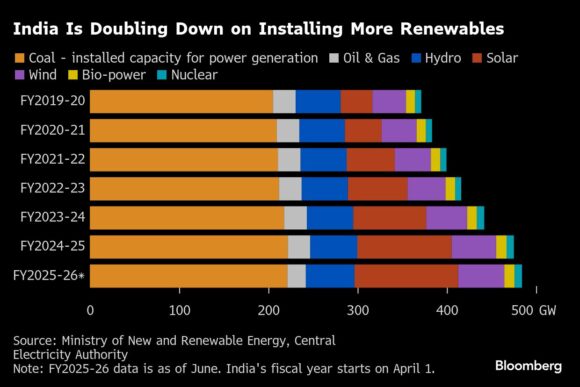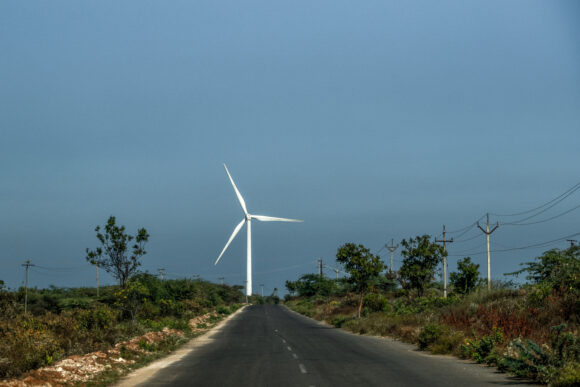Solar and wind energy companies are betting on a novel form of insurance to protect their assets against wild and volatile weather — the very type of climate risk they were set up to fight.
Renewable power projects can lose substantial revenue if the wind fails to blow, if clouds block the sun, or when a hurricane slams into expensive infrastructure. To protect against such climate-induced losses, many owners are turning to parametric insurance, a product providing rapid compensation when certain weather-related metrics are met. The downside is that if the pre-defined trigger is missed by even a tiny amount, there is no payout. And the money that’s paid may end up covering only a small portion of actual losses.
Even so, more clean-energy companies are using parametric insurance to supplement traditional indemnity programs. “It’s definitely an area we see growing massively,” said Marcel-Steffen Reif, global head of weather and AgRisk Partners at reinsurer Munich Re.
The shift is being driven by the rising impact of global warming on green assets. In Texas, solar farms are routinely battered by hail, while wind farms suffer massive damage during winter storms. Australia is seeing lower wind speeds in some areas and more cloud cover in others. Nearly half of Europe’s renewable power capacity will be at “critical risk” from extreme weather unless more is done to protect them, according to Zurich Insurance Group AG.
Read more: Insured Losses From US Hurricanes Could Rise by 50% With Global Warming
Indonesia, Malaysia and Brunei have witnessed large declines in solar irradiation, and Qatar and Kuwait have seen a slump in wind speed this century, according to Copernicus Climate Change Service data analyzed by Bloomberg.

The threat is especially severe in India, where Prime Minister Narendra Modi’s plan to more than double renewable energy capacity by 2030 could be undermined by the country’s high susceptibility to wind droughts and reduced solar irradiation. Wind power generation there fell by 0.77 petawatt-hour per decade between 1980 and 2016, according to a 2018 study, as a lower differential between temperatures on land and the Indian Ocean sea slowed wind flows.
Such unpredictability “increases the amount of equity needed to fund a project, which is obviously a barrier to development,” said Iain Staffell, associate professor in sustainable energy at Imperial College London.
A few years ago, ReNew Energy Global Plc bought parametric insurance for a modest-sized project, seeking to protect revenues from a potential drop in wind speed. But when it made a claim, the insurer declined to pay, saying the fault lay with a faulty turbine instead of variable weather. Renew says the lack of a payout discouraged it from buying parametric cover for larger projects.
“Wind has continued to underperform in the last three to four years” so the declines will have to be significantly worse to get insurers to pay out, said Kailash Vaswani, chief financial officer of ReNew. “It’s basically heads they win, tails you lose.”
Some clean-energy companies worry about the cost. Actis GP LLP, which manages $108 billion in assets together with parent General Atlantic, is in discussions with insurers “to see whether the pricing level justifies the risk coverage,” said Abhishek Bansal, managing director for energy infrastructure at Actis.
Read More: Hedge Fund Strategy Built on Catastrophes Taps a Hot New Trend – Parametrics
Foreign insurers, nonetheless, see a growing opportunity in emerging markets. Munich Re says it has received “first requests” from clean energy companies in India and China. Willis Towers Watson Plc says it has seen a “doubling of demand” from Indian developers since 2023. Paris-based Descartes Underwriting is pitching wind parametric products in several developing countries.
“There’s no comparable product in the traditional markets,” said Christopher Au, director, climate practice and alternative risk transfer solutions for Asia Pacific at WTW. Banks are setting requirements for some assets to be insured, which “is an important motivating factor for developers,” he said.
The promise of speedy payouts has made parametric deals especially popular as a hedge against losses tied to the physical impact of global warming — everything from more intense wind gusts that dislodge solar panels, to more frequent lightning strikes that damage turbines. When Typhoon Rai hit the Philippines in late 2021, Aboitiz Power Corp. was able to collect a parametric payout within 30 days and quickly repair the damage caused to its renewable energy assets.
“Extreme weather events are more severe and more frequent in the Asia region,” said Jeong Won Kim, senior research fellow at the National University of Singapore. In time, “more and more parametric insurance products will emerge” to help the renewables sector cope with the risk, she said.
Photograph: Wind turbines off a national highway in Tirunelveli District, Tamil Nadu, India on Wednesday, March 20, 2024. India, the world’s most-populous nation, has signaled it will reduce its dependence on the fossil fuel, but growing energy needs complicate the equation. Photo credit: Prashanth Vishwanathan/Bloomberg
Topics Climate Change
Was this article valuable?
Here are more articles you may enjoy.



 Icahn Money Manager Sues His Bosses and Bausch + Lomb Over Anti-White Bias
Icahn Money Manager Sues His Bosses and Bausch + Lomb Over Anti-White Bias  Aon Adds to List of Brokers Suing Howden US for Alleged Poaching, Theft
Aon Adds to List of Brokers Suing Howden US for Alleged Poaching, Theft  UPS Ripped Off Seasonal Workers With Unfair Pay Practices, Lawsuit Alleges
UPS Ripped Off Seasonal Workers With Unfair Pay Practices, Lawsuit Alleges  Poorer Americans Dropped Federal Flood Insurance When Rates Rose
Poorer Americans Dropped Federal Flood Insurance When Rates Rose 

